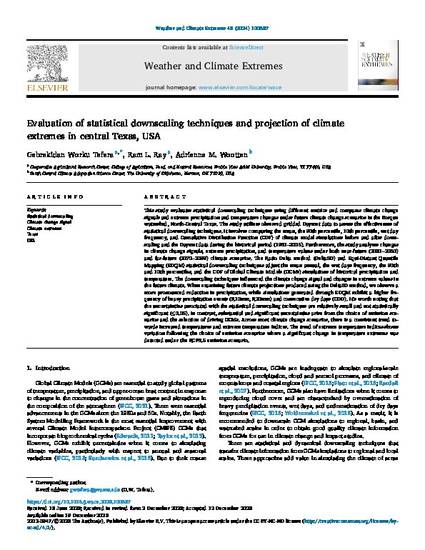
Article
Evaluation of statistical downscaling techniques and projection of climate extremes in central Texas, USA
Weather and Climate Extremes
(2024)
Abstract
This study evaluates statistical downscaling techniques using different metrics and compares climate change
signals and extreme precipitation and temperature changes under future climate change scenarios in the Bosque
watershed, North-Central Texas. The study utilizes observed gridded Daymet data to assess the effectiveness of
statistical downscaling techniques. It involves comparing the mean, the 90th percentile, 10th percentile, wet day
frequency, and Cumulative Distribution Function (CDF) of climate model simulations before and after downscaling
and the Daymet data during the historical period (1981–2005). Furthermore, the study analyzes changes
in climate change signals, extreme precipitation, and temperature values under both near-future (2031–2060)
and far-future (2070–2099) climate scenarios. The Ratio Delta method (DeltaSD) and Equi-Distant Quantile
Mapping (EDQM) statistical downscaling techniques adjust the mean annual, the wet days frequency, the 90th
and 10th percentiles, and the CDF of Global Climate Models (GCMs) simulations of historical precipitation and
temperature. The downscaling techniques influenced the climate change signal and changes in extreme values in
the future climate. When examining future climate projections produced using the DeltaSD method, we observe a
more pronounced reduction in precipitation, while simulations generated through EDQM exhibit a higher frequency of heavy precipitation events (R10mm, R20mm) and consecutive dry days (CDD). It’s worth noting that
the uncertainties associated with the statistical downscaling techniques are relatively small and not statistically
significant (≤0.05). In contrast, substantial and significant uncertainties arise from the choice of emission scenarios and the selection of driving GCMs. Across most climate change scenarios, there is a consistent trend towards increased temperatures and extreme temperature indices. The trend of extreme temperature indices shows variation following the choice of emission scenarios where a significant change in temperature extremes was detected under the RCP8.5 emission scenario.
Keywords
- Statistical downscaling Climate change signal Climate extremes Texas USA
Disciplines
Publication Date
Winter January 19, 2024
DOI
https://doi.org/10.1016/j.wace.2023.100637
Citation Information
Gebrekidan Tefera, Ram L Ray and Adrienne M. Wootten. "Evaluation of statistical downscaling techniques and projection of climate extremes in central Texas, USA" Weather and Climate Extremes Vol. 43 (2024) Available at: http://works.bepress.com/gebrekidan-tefera/24/
Creative Commons license

This work is licensed under a Creative Commons CC_BY-NC International License.
